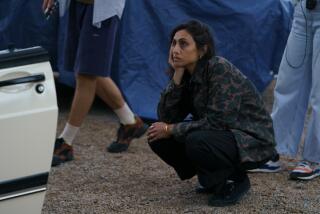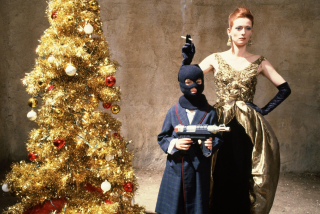Mother Varda’s movies
- Share via
AGNES VARDA is often called the mother of the French New Wave, the loose collective of filmmakers who galvanized international cinema in the ‘60s and whose ranks included Jean-Luc Godard, Francois Truffaut, Alain Resnais, Jacques Rivette, Eric Rohmer, Claude Chabrol and Varda’s late husband, Jacques Demy.
Not only was Varda a virtually lone female voice in this boys’ club, her emergence actually predated theirs by several years. Godard’s “Breathless” (1960) is often identified as ground zero of the movement, but in 1956 Varda planted the seeds of the revolution with “La Pointe Courte,” a low-budget production whose casually radical mingling of fiction and documentary anticipated the New Wave house style and some of the more adventurous art cinema to come.
Criterion’s Varda set, out Tuesday ($99.95), includes that quietly seismic debut and three more of this undervalued director’s most important films. “Cleo From 5 to 7” (1962) is an incredibly moving real-time account of a young singer awaiting a medical diagnosis; Varda once called it “a portrait of a woman painted onto a documentary of Paris” (Richard Linklater’s Paris-set “Before Sunset” is a fond homage). The ironically titled “Le Bonheur” (“Happiness,” 1965) is, like “La Pointe Courte,” a chronicle of a failing marriage, distinguished by an almost cruelly vibrant color palette. “Vagabond” (1985) recounts the life of a dead teenage drifter (Sandrine Bonnaire) through the individuals she encountered -- a sort of “Into the Wild” without the wanderlust romance.
Varda, who turns 80 this year, spoke from the Paris office of her production company, Cine-Tamaris.
You’re often called the mother of the French New Wave. Do you think that’s an accurate label?
Or even grandmother sometimes. It’s fine with me. They only call me that because I started early. I was an early bird of that spring. The “nouvelle vague” name -- the “New Wave” -- was given to a group of filmmakers years after the films came out. The term is very odd because we were so different. It’s not really a group, it’s not a club. But my first film, “La Pointe Courte,” had the freedom of the New Wave directors. It was totally independent auteur cinema. I wrote the script, I found the place, I worked with nonactors, I hired unknown actors. It was the first film for Philippe Noiret [who went on to a long and illustrious film career]. He was a theater actor, and I was the photographer for the Avignon Theater Festival. That’s how I had access. Not a single film actor would have taken a chance with a 25-year-old girl who had no film experience.
Many of the major French directors at the time started out as film critics.
Yes, but I was never one. My background was in photography and art history, learning to look at paintings. I think that background informs my understanding and desire when it comes to filmmaking, but who knows? I always made films just based on my feelings.
You’ve moved comfortably between documentary and fiction throughout your career.
I’m going from one to another but also mixing all the time. I always get my inspiration from real things. In fiction films, like “La Pointe Courte” or “Vagabond,” I start by observing and talking to real people. I write a script and the film is totally organized, but I like to keep a documentary texture. I’m not the only one doing that, of course. In France, we had a great director, Maurice Pialat, who directed nonactors beautifully. It’s true and not true at the same time, which I love.
Right now, I’m almost finished shooting a documentary about myself, a self-portrait called “Les Plages d’Agnes” -- “The Beaches of Agnes.” It’s a documentary, but I’m acting in it. That line between documentary and fiction -- I cheat all the time.
More to Read
Only good movies
Get the Indie Focus newsletter, Mark Olsen's weekly guide to the world of cinema.
You may occasionally receive promotional content from the Los Angeles Times.










